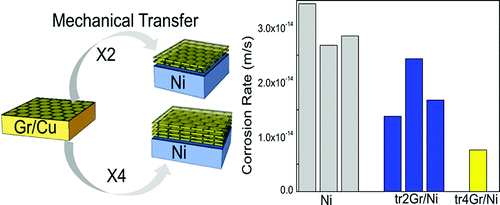Graphene is thinnest known anti-corrosion coating

New research has established the "miracle material" called graphene as the world's thinnest known coating for protecting metals against corrosion. Their study on this potential new use of graphene appears in ACS Nano.
In the study, Dhiraj Prasai and colleagues point out that rusting and other corrosion of metals is a serious global problem, and intense efforts are underway to find new ways to slow or prevent it. Corrosion results from contact of the metal's surface with air, water or other substances. One major approach involves coating metals with materials that shield the metal surface, but currently used materials have limitations. The scientists decided to evaluate graphene as a new coating. Graphene is a single layer of carbon atoms, many layers of which are in lead pencils and charcoal, and is the thinnest, strongest known material. That's why it is called the miracle material. In graphene, the carbon atoms are arranged like a chicken-wire fence in a layer so thin that is transparent, and an ounce would cover 28 football fields.
They found that graphene, whether made directly on copper or nickel or transferred onto another metal, provides protection against corrosion. Copper coated by growing a single layer of graphene through chemical vapor deposition (CVD) corroded seven times slower than bare copper, and nickel coated by growing multiple layers of graphene corroded 20 times slower than bare nickel. Remarkably, a single layer of graphene provides the same corrosion protection as conventional organic coatings that are more than five times thicker. Graphene coatings could be ideal corrosion-inhibiting coatings in applications where a thin coating is favorable, such as microelectronic components (e.g., interconnects, aircraft components and implantable devices), say the scientists.
More information: Graphene: Corrosion-Inhibiting Coating, ACS Nano, Article ASAP. DOI: 10.1021/nn203507y
Abstract
We report the use of atomically thin layers of graphene as a protective coating that inhibits corrosion of underlying metals. Here, we employ electrochemical methods to study the corrosion inhibition of copper and nickel by either growing graphene on these metals, or by mechanically transferring multilayer graphene onto them. Cyclic voltammetry measurements reveal that the graphene coating effectively suppresses metal oxidation and oxygen reduction. Electrochemical impedance spectroscopy measurements suggest that while graphene itself is not damaged, the metal under it is corroded at cracks in the graphene film. Finally, we use Tafel analysis to quantify the corrosion rates of samples with and without graphene coatings. These results indicate that copper films coated with graphene grown via chemical vapor deposition are corroded 7 times slower in an aerated Na2SO4 solution as compared to the corrosion rate of bare copper. Tafel analysis reveals that nickel with a multilayer graphene film grown on it corrodes 20 times slower while nickel surfaces coated with four layers of mechanically transferred graphene corrode 4 times slower than bare nickel. These findings establish graphene as the thinnest known corrosion-protecting coating.
Provided by American Chemical Society



















